The NVIDIA GeForce GTX 1650 Review, Feat. Zotac: Fighting Brute Force With Power Efficiency
by Ryan Smith & Nate Oh on May 3, 2019 10:15 AM ESTWolfenstein II: The New Colossus (Vulkan)
id Software is popularly known for a few games involving shooting stuff until it dies, just with different 'stuff' for each one: Nazis, demons, or other players while scorning the laws of physics. Wolfenstein II is the latest of the first, the sequel of a modern reboot series developed by MachineGames and built on id Tech 6. While the tone is significantly less pulpy nowadays, the game is still a frenetic FPS at heart, succeeding DOOM as a modern Vulkan flagship title and arriving as a pure Vullkan implementation rather than the originally OpenGL DOOM.
Featuring a Nazi-occupied America of 1961, Wolfenstein II is lushly designed yet not oppressively intensive on the hardware, something that goes well with its pace of action that emerge suddenly from a level design flush with alternate historical details.
The game has 5 total graphical presets: Mein leben!, Uber, Ultra, Medium, and Low. Staying consistent with previous 1080p testing, the highest quality preset, "Mein leben!", was used, in addition to Ultra and Medium. Wolfenstein II also features Vega-centric GPU Culling and Rapid Packed Math, as well as Radeon-centric Deferred Rendering; in accordance with the presets, neither GPU Culling nor Deferred Rendering was enabled.
To preface, an odd performance bug afflicted the two Maxwell cards (GTX 960 and GTX 950), where Medium Image Streaming (poolsize of 768) resulted in out-of-memory sub 2-fps performance. Using the Medium preset but with any other Image Streaming setting returned to normal performance, suggesting an issue with memory allocation, and occuring on earlier drivers as well. It's not clear how much this affects sub 2-fps performance at the "Mein leben!" preset, which is already much too demanding for 2GB of framebuffer.
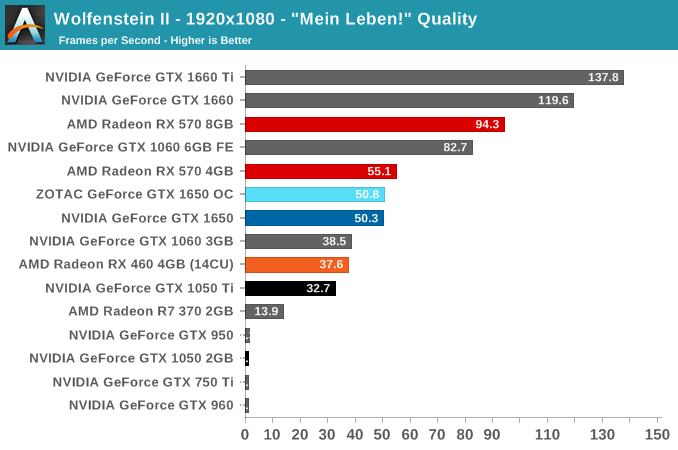
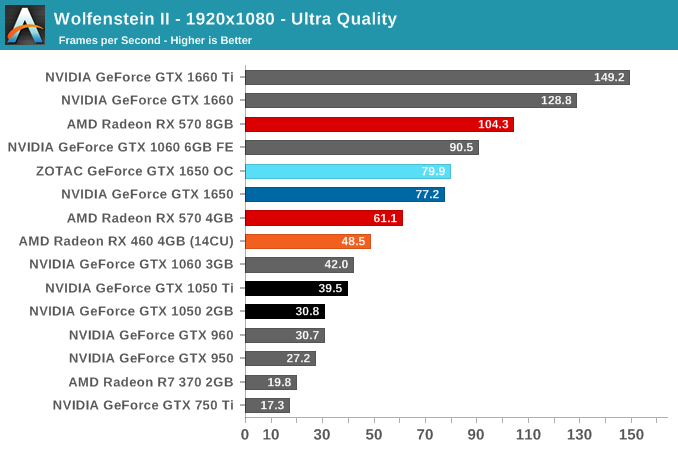
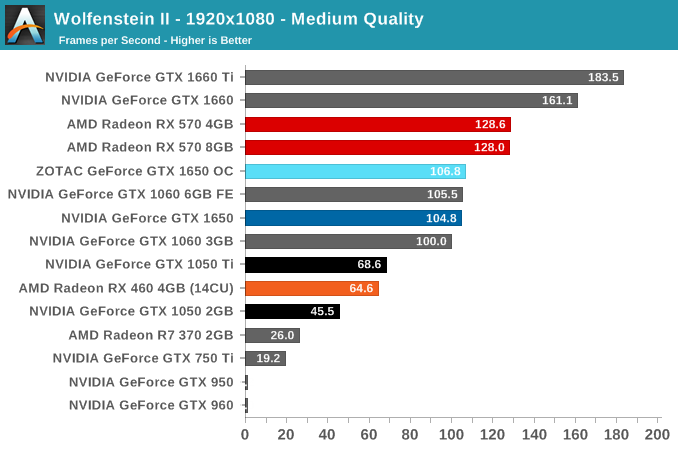
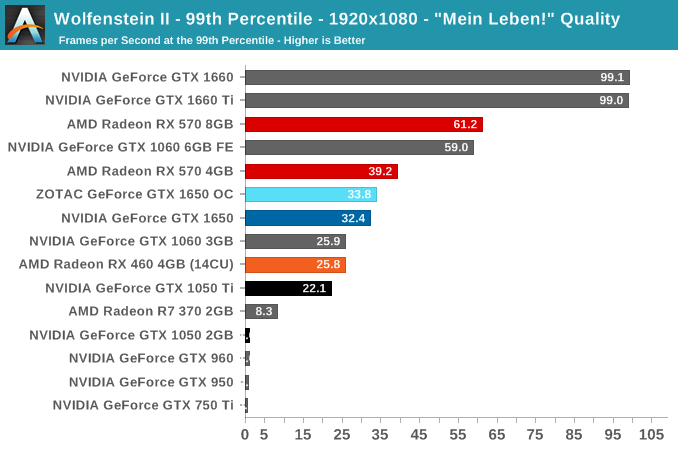
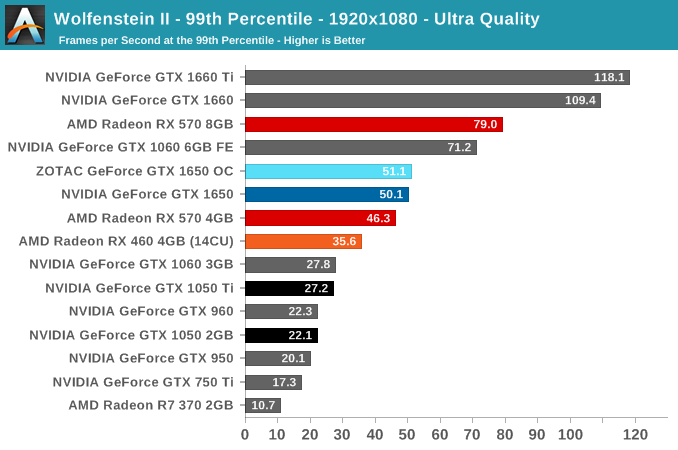

With the VRAM-hungry nature of Wolfenstein II, the GTX 1650's 4GB keeps it from suffering a premature death like all the other 2GB cards. Or even the 3GB card, in the case of the GTX 1060 3GB. Even at medium settings, the bigger framebuffer turns the tables on the GTX 1060 3GB, which is faster in every other game in the suite. So the GTX 1650 takes the lead in both performance and smoother gameplay experience.
The VRAM-centric approach does uncover more oddities; here the GTX 1650 overcomes the RX 570 4GB at higher settings, but the RX 570 8GB remains undeterred.


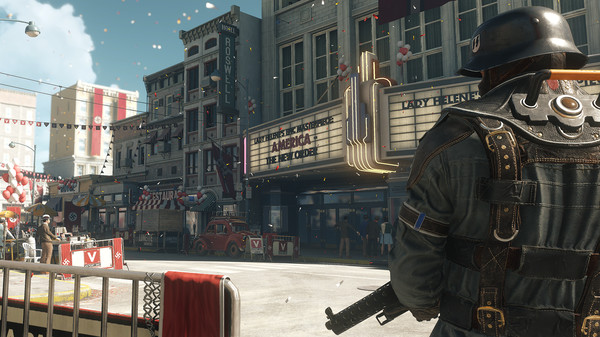








126 Comments
View All Comments
nevcairiel - Saturday, May 4, 2019 - link
A P-Frame (Predictive Frame) by definition is only in one direction - backwards. B-Frames (Bidirectional Predictive Frame) are allowed in both directions. This is an import distinction because it matters in which order those frames are put into the encoded video. "Future" frames of course need to be send first, or you can't use them for prediction.Thats where pattern like "IPBBB" come from. You start with a single I frame, a single P frame referencing that I frame (the P might be shown after some B frames), and then an array of B frames that reference both the I and P frames - and possibly each other.
P and B frames are otherwise identical in how they work. Both contain motion vectors and entropy data to correct the interpolation.
Also note that H264 already supported up to 16 reference frames for interpolation. Its called bidirectional not because its two frames, but two directions - past and future.
Opencg - Friday, May 3, 2019 - link
please include fortnight average fps over 10 hour playtime. for all cards. all on the same patch. thxBulat Ziganshin - Friday, May 3, 2019 - link
The "NVIDIA is holding back a bit" part is duplicated on pages 1 and 2Ryan Smith - Friday, May 3, 2019 - link
Whoops. That was meant to get excised when I rearranged the article. Thanks!eva02langley - Friday, May 3, 2019 - link
This card shouldn't exist.R7 was making sense because it was cheaper than a 2080, however this is more expensive than a RX 570... AND WEAKER!
Oxford Guy - Saturday, May 4, 2019 - link
It apparently exists for the GTX 960 buyers (the people who don't do their homework).eek2121 - Friday, May 3, 2019 - link
In before 1650ti. ;)AshlayW - Friday, May 3, 2019 - link
Wow. This card makes no sense. Go watch hardware unboxed's video where he conveniently shoots down the "power efficiency" argument. It's a load of rubbish, there is absolutely no reason to buy this card over even the 4GB 570, for any new gaming build. This review tried so hard to paint this turd in a positive light, continually underscoring AMD's "technological disadvantages" and "thin profit margin". P20 isn't even that much bigger than TU117 also.I'm sorry I just feel it is too friendly to nvidia and doesn't criticize this terrible product pricing enough. RX570 8GB pulse, fro sapphire is cooler running, quieter, vastly higher build quality, >10% faster, twice the vram and 135W board power, which is perfectly fine even for potato OEM builds anyway.
Seriously, drop Ty efficiency arguy. This card is DOA at 149 because 570 killed it.
1024 CC card at 130 bucks would've been passable, not this joke.
AshlayW - Friday, May 3, 2019 - link
The 570 8Gb pulse is also the same price or cheaper than 1650, at least here in the UK. Forgot to mention that important point.AshlayW - Friday, May 3, 2019 - link
Typos as I'm on my phone and I have fat fingers.Should read: "drop the efficiency argument"